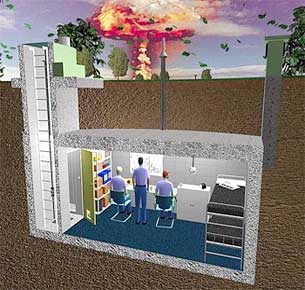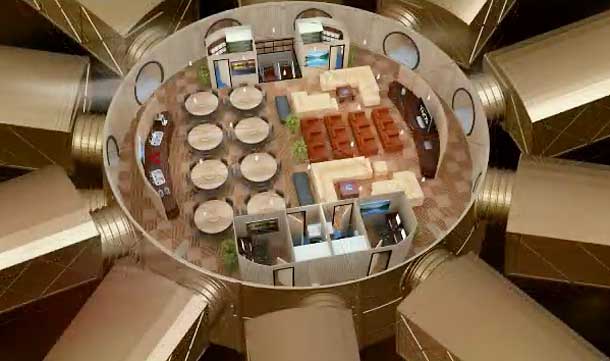Underground Bunkers
When you're assessing the threats that you wish to protect your
family from, you'll find that underground bunkers will give you
optimal protection. You may use your shelter for severe weather
now as in the case of natural disasters, and it will be used in
the eventuality of nuclear, chemical or biological attacks.
 Underground
Bunker
Underground
Bunker |
The ideal shelter needs to offer two separate
elements. It should guard you against any initial disaster,
whether that is man-made or natural. It also must protect
you and your family for a number of days after the first
disaster.
|
Your shelter needs to deflect any initial blast, and explosions,
or you may suffer internal injuries. This is essential, or the
underground bunker will not have fully served its purpose.
The blast door is an important part of your underground bunker
design. In the case of nuclear attack, the doors should seal so
that your shelter is airtight. Initially, the door should be formed
so that it will not be curled back in the stress of the second
wave. The door must also be made with strong materials that will
guard your shelter against radiation.
|
Want to Be on Survivalism
TV?
Here is your chance. National Geographic's Doomsday
Preppers TV show is casting for its upcoming season
and want to include underground home owners who are also
survivalists. Just click on the link below, fill out the
questionaire and send it in (not to us, to them!).
National
Geographic
|
Underground bunkers are preferable to other types of shelters
since they provide immediate protection for you during the time
of the initial disaster, and in the second wave, which is called
underpressure. Above ground shelters will not adequately protect
you from radiation. Be sure to include proper ventilation in your
bunker, using a filter for nuclear and bio-chemical filtration.
These are known as NBC filters.
Soil is a good insulator, and radiation gives off heat, so if
your bunker is not properly vented and below grade, it will become
too hot for you to remain in it. The oxygen levels will also dip
dangerously low. The money you spend is an investment in the future
of your family, and you can't put a price tag on feeling safe
in the case of a disaster.
Protection Connection ...
Concrete bunkers protect you against many types of threats. Adding
a reinforced bathroom that is also below ground level will be
a plus, as well. Reinforcing the bunker will offer protection
from explosions, home intrusion and radiation. Any serious explosion
will damage or destroy your above-ground home. Bunkers will withstand
a level of several hundred psi, so this will be protective for
your family after a bomb explosion.

Some people have a safe room in their home, to use in the case
of a disaster. If you're only worried about intruders, hidden
rooms can suffice. But if your concern extends to protecting your
family from military-type assault and radiation, a concrete bunker
will be much safer. Well-designed bunkers work at deflecting a
blast wave. You should select a professional with experience in
constructing bunkers, to give your family the ultimate in safety.
A few inches of soil will usually address any concerns you have
about radiation. Soil helps in shielding underground
shelters. In addition, the bunker should be placed so that
water will drain away from it. A trap door can be an adequate
entrance, since it will minimize your exposure to the outdoors.
A door at ground level, and sunk into the door frame will keep
from a blast lifting the door up. Dual doors will offer even greater
protection for you and your family, when disaster strikes.
Fall Out, Soldier!
Some people who construct underground homes do so in such a way
that they serve as fallout bunkers as well. Others who live in
underground homes will have a different fallout shelter constructed
nearby on the same land as the home.
And, there is another type of underground house that is very
safe in the case of weapons of mass destruction being dropped
nearby and that is repurposing abandoned missile
silos into homes as a handful of people across the U. S. have
already done.
The choice is up to you, however, in how you want to stay safe,
live green, and not worry so much about the future.
|

